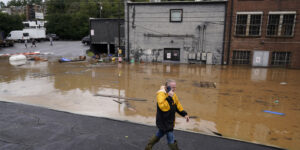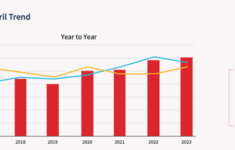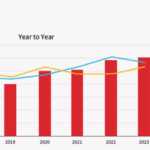More than 50 years ago, nearly a dozen men incarcerated outside of Philadelphia enrolled in an experiment funded by Johnson & Johnson, according to unsealed documents. Now, those studies have come back to haunt the world’s largest maker of healthcare products.
In one study, inmates were paid to be injected with potentially cancer-causing asbestos so the company could compare its effect on their skin versus that of talc, a key component in its iconic baby powder.
University of Pennsylvania dermatologist Albert Kligman conducted hundreds of human experiments over two decades at Holmesburg Prison in Pennsylvania. The testing regime, funded by entities such as Dow Chemical and the U.S. government, involved mostly Black inmates and first came to light decades ago in books and newspaper articles. But J&J’s involvement in the talc studies focusing on asbestos hasn’t been made public in the media before now.
The unsealed prison-testing files came to light in two trials last year over legal claims that J&J’s talc-based powder causes cancer, and legal experts say that information could be powerful evidence in future cases, justifying punishment awards.
While they didn’t dispute the company hired Kligman in the 1960s to do baby powder tests, J&J officials said they regretted the firm’s involvement with the dermatologist. Still, they noted the tests didn’t violate research standards at the time.
“We deeply regret the conditions under which these studies were conducted, and in no way do they reflect the values or practices we employ today,” Kim Montagnino, a company spokeswoman, said in an emailed statement. “As the world’s largest healthcare company, our transparent, diligent approach to bioethics is at the heart of all we promise our customers and society.”
Talc Lawsuits on Hold
Since 2013, J&J has defended itself from accusations that its talc-based baby powder, for years a bathroom staple for women and babies, contained cancer-causing asbestos. It has lost some cases, including one where it paid $2.5 billion in damages and interest, won others and had some suits thrown out.
The company withdrew its talc-based baby powder from the U.S. and Canadian markets in 2020, citing slipping sales. Over the last five years, J&J shares returned about 36 percent on a total return basis, lagging the S&P 500 index by about 55 percentage points. In 2021, J&J posted returns of less than half the S&P.
Lawyers for talc plaintiffs pushed to get J&J’s testing files made public for years. It wasn’t until a judge allowed jurors to hear testimony about the documents in a 2021 California case that they surfaced. That jury ordered J&J to pay a woman more than $26 million last year, some in the form of punitive damages, over the company’s handling of its baby powder line.
Asbestos, a mineral often found where talc is mined, was identified as a carcinogen by U.S. researchers in the 1950s. J&J has steadfastly maintained there has never been asbestos in its talc, and it hasn’t accepted responsibility for any injuries blamed on the product.
Talc litigation is currently on hold while a J&J unit is in bankruptcy. Last year, the company executed a controversial tactic known as a “Texas Two Step” in hopes of corralling the talc litigation’s costs. The company set up a separate cosmetics unit under a business-friendly Texas law and put it into bankruptcy. Last month, the judge cleared J&J to proceed with efforts to use the Chapter 11 case to settle more than 40,000 cancer cases.
In the unit’s bankruptcy filing, J&J lawyers noted the company already had paid more than $3.5 billion to cover settlements and verdicts in the eight-year talc litigation. Over a recent five-year period, the company also paid another $1 billion to cover defense costs tied to talc suits.
The Kligman Connection
Even if J&J is successful in resolving most of the talc cases through the bankruptcy case, some victims are likely to opt out of the deal and seek their day in court, said Carl Tobias, a University of Richmond law professor who follows the litigation. He said the testing files could wind up being part of punitive-damages presentations in coming trials.
“This is some pretty horrific stuff, and the plaintiffs will definitely want to use it to show J&J’s handling of its baby powder line over the years hasn’t been the greatest,” Tobias said. “J&J marketed itself as family-friendly company. This kind of testing doesn’t seem family friendly to me.”
While jurors heard about the results of Kligman’s asbestos study, they weren’t told the test was done on prison inmates or their race for fear of unduly prejudicing the panels against J&J. That could change in future lawsuits, Tobias noted.
Joseph Satterley, a California-based plaintiffs’ lawyer, represented Christina Prudencio, the California teacher who won $26.4 million from J&J last year after claiming her life-long use of the talc-based powder led her to develop an asbestos-linked cancer. He argues Kligman’s talc experiments at Holmesburg show J&J was worried about asbestos in its talc decades ago.
“Why else would they pay Kligman to inject asbestos into prisoners?” Satterley asked. “They didn’t just pick asbestos out of thin air.”
Asbestos Testing
Kligman, who first came to Holmesburg to treat an athlete’s foot outbreak in 1951, quickly recognized the research opportunities. Prisoners were paid between $10 and $300 to participate in his studies, said Allen Hornblum, an ex-prison social worker who wrote the first book about the testing. Regular jail jobs paid 25 cents a day, he noted.
For the asbestos test, Kligman recruited 10 prisoners in 1971 to get injections of tremolite and chrysotile asbestos, along with a talc shot in their lower backs, according to the unsealed files.
David Egilman a Brown University medical professor, testified as an expert for plaintiffs in several talc cases about Kligman’s December 1971 report to J&J. The chrysotile form of asbestos “had the biggest effect” on inmates’ skin, causing “granulomas, which are cells clumped together causing a raised area,” Egilman said. Such bumps can be an indicator of lung disease or other ailments linked to asbestos exposure, researchers say.
The unsealed files also show Kligman and his colleagues did other Holmesburg studies to evaluate whether the type of containers used to store baby powder had any effect on skin.
In a 1968 report, Kligman noted “50 healthy adult males were selected from the population of Philadelphia County Prison at Holmesburg.” The men, 44 of whom were Black, had talc from different canisters applied to their skin and covered with dressings. Neither sample from the different containers caused a reaction, Kligman wrote.
Leodus Jones, one of the prisoners who signed on to some of Kligman’s studies, said in a newspaper interview in the late 1990s the tests left white scars on his back. His daughter’s first glimpse of the human toll left her shaken.
“I was four or five when I first saw my father’s back, and it scared me so badly, I ran to my mother and told her that daddy had turned into a monster,” Adrianne Jones-Alston said in an interview.
Jones, who died in 2018 at the age of 74, couldn’t remember if he was a J&J test subject, his daughter said. She’s pushing Penn to pay reparations to the families of Holmesburg prisoners who participated in the research. Kligman’s testing ended in 1974 after a public outcry about the studies.
Last year, Penn’s medical school apologized for backing Kligman’s testing and renamed his dermatology professorship for a Black colleague. “Penn Medicine apologizes for the pain Dr. Kligman’s work caused to incarcerated individuals, their families and our broader community,” J. Larry Jameson, the medical school’s dean, said in August 2021.
Kligman, who died in 2010, never acknowledged any wrongdoing. “My use of paid prisoners as research subjects in the 1950s and 1960s was in keeping with this nation’s standard protocol for conducting scientific investigations at the time,” he told the Baltimore Sun in 1998.
(To contact the author of this story: Jef Feeley in Wilmington at jfeeley@bloomberg.net)





















 Global Natural Catastrophe Insured Losses Exceed $102B During Q1-Q3 2024: Aon
Global Natural Catastrophe Insured Losses Exceed $102B During Q1-Q3 2024: Aon  Chubb Continues ‘Record’ Year With 13.8% Jump in Q3 Net Income
Chubb Continues ‘Record’ Year With 13.8% Jump in Q3 Net Income  The Data Behind Rising Homeowners Premiums: By Peril and By State
The Data Behind Rising Homeowners Premiums: By Peril and By State  Global Reinsurers’ ROE Jumps to 22% in 2023, but Market Softening Unlikely: AM Best
Global Reinsurers’ ROE Jumps to 22% in 2023, but Market Softening Unlikely: AM Best 